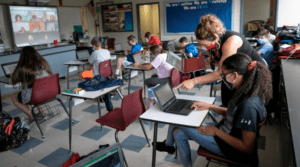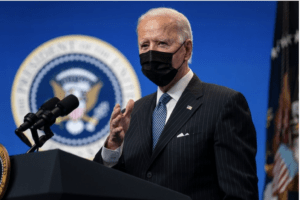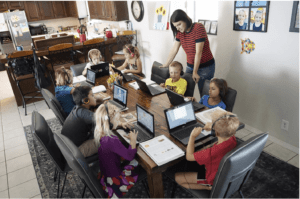
For nearly a year, schools in the United States have adapted to the pandemic by utilizing distance-learning models with varying success levels. Many studies indicate that the interruption to in-person learning has drastically affected standardized test scores, graduation rates, absenteeism, and social development for all students. The heaviest toll falls on Black, Hispanic, and low-income students, many of whom rely on school systems for food, healthcare, and financial assistance. Data collected in April 2020 showed that only 61% of families whose children received free or reduced lunches received similar meal assistance during school closures.
The racial disparity in remote learning is a powerful argument in the push to reopen schools. Still, could the risk of reopening schools too soon be just as harmful as the risk of maintaining current remote operations? If students, teachers, and staff resume in-person learning, how will we prevent “super spreader” events and cluster infections?
President Biden’s Proposal

The new administration’s American Rescue Plan aims to safely reopen schools to at least one day of in-person learning by President Biden’s 100th day in office (April 2021). Many aspects of this plan are recommendations set by the CDC, including the now commonplace practices of social distancing, mask-wearing, and increased hand-washing. More complex initiatives include testing and contact tracing operations within school health clinics, in-depth screening procedures, ramped-up cleaning protocols for facilities, and updated ventilation systems.
Implementing such changes requires vast amounts of funding. President Biden’s proposal calls for a whopping $130 billion to reopen schools. Critics of this plan claim that it is too fast, too costly, or not backed by enough scientific evidence to be considered safe. Dr. Anthony Fauci, Director of the National Institute of Allergy and Infectious Diseases, supports the return to in-person learning, so long as CDC guidelines are followed. Dr. Fauci also suggested that schools limit or adapt certain activities that may increase the risk of COVID-19 transmissions, such as indoor sports practices and other extra-curricular events.
School-Related Infections
A recent report published in the American Medical Association Journal states that there is “little evidence that schools have contributed meaningfully to increased community transmission” of Sars-CoV-2. During the fall of 2020, 11 North Carolina school districts held in-person classes for over two months. Within this time frame, 32 COVID-19 school-related cases popped up compared to 773 “community-acquired” infections. Further, none of the school-related cases have been traced from students to staff.
Data from 12 European Union countries showed that cluster infections within schools could not be definitively traced to “in-school” or “community-based” transmissions. The same data set also noted that teachers and non-teachers were infected at similar rates, indicating that schools were not associated with “accelerating” COVID-19 infections. Conversely, the reintroduction of in-person classes for two weeks in Israel during May of 2020 resulted in nearly 200 COVID-19 cases. Reports for this event detail a lack of social distancing in classrooms, numerous face-mask exemptions, and lack of air circulation due to a heatwave.
Teachers’ Unions Push Back
Under President Biden’s lofty deadline, some teachers are concerned that their school districts could reopen before it was safe to do so. President of the United Educators of San Francisco, Susan Solomon, has stated that vaccinations are necessary for schools to begin in-person classes again. Solomon has argued “it can’t just be every teacher,” demanding the immunization of every employee within the school receive the vaccine because “transmission between adults is the highest form of transmission.”
Contrary to this stance, in a coronavirus task force briefing on February 17, Dr. Fauci stated that vaccinating every teacher before reopening schools is “impractical” and should not be considered a requirement before opening the doors. Dr. Fauci noted that states should make every effort to vaccinate educators as quickly as possible.
Randi Weingarten, President of the American Federation of Teachers, has stated that districts should address specific needs and concerns before teachers begin in-person schooling, even before widespread vaccination occurs. Including:
- Allowing those with compromised immune systems, or individuals caring for those with such conditions, to continue remote work,
- In-school testing procedures
- Assurances from school districts that they will report cases and cease operations when necessary
Innovative Solutions or Long-Term Problems?
Parents and guardians have tried innovative solutions for multimodal instruction without the heightened risk of coronavirus transmission from schools.

For some privileged families, that means investing in a private school that can offer resources like personal protection equipment, smaller class sizes, and a better-equipped health clinic. Other families are hiring private tutors and hosting classes in their homes. These solutions are not necessarily a financial or feasible option for all families, which could further the racial and socioeconomic disparities in primary conditions for learning.
In New Jersey, Los Angeles, and San Francisco, the pod system has generated vast amounts of interest in the past months. Typically, these pods include two or three families and a teacher or tutor to instruct the appropriate curriculum. Some families hire tutors and use this pod system as a supplement for their children’s online classes. This helps to free up the parent’s time and allowing for social interaction among the children. Some families may take their children out of school altogether and rely solely on private education within the pod.
These pod systems, or micro-schools, are costly, difficult to coordinate, and often only an option for privileged families. Broward County Public Schools in South Florida, the sixth-largest school district in the US, lost 9,000 enrolled students to “alternatives to virtual education.” Mr. Robert Runcie, Broward’s superintendent, warned that if students remain in private schools, funding will drop, “forcing layoffs” and reducing the resources for the lower-income students who cannot afford alternative options. As President Biden’s plan and CDC guidelines require more teachers in schools, these alternative solutions could cause damage to public school systems and underserved populations.
Back to School?
As the 100-day countdown marches on, funding to reopen and teachers’ vaccinations remain in question. While the new administration has implemented a plan following the CDC guidelines, their wishy-washy stance on teachers’ vaccination has unions demanding more safeguards. Critics of the proposal’s financial components may create obstacles to establishing the precautions endorsed by Dr. Fauci. As parents continue to shift towards private alternatives, what will schools look like when we return?
